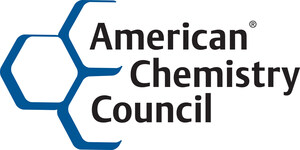Consumer, Business Confidence Reach Levels Not Seen In Decades; Optimism Reflected In Increased Chemical Industry Activity
WASHINGTON, March 21, 2017 /PRNewswire/ -- The Chemical Activity Barometer (CAB), a leading economic indicator created by the American Chemistry Council (ACC), posted its strongest year-over-year gain in nearly seven years. The 5.5 percent increase over this time last year reflects elevated consumer and business confidence and an overall rising optimism in the U.S. economy. Speaking last week, Federal Reserve Chairwoman Janet Yellen also referenced a "confidence in the robustness of the economy" as a reason to move forward with an interest rate hike.
The barometer posted a 0.5 percent gain in March, following a 0.5 percent gain in February and 0.4 percent gain in January. All data is measured on a three-month moving average (3MMA). Coupled with consecutive monthly gains in the fourth quarter of 2016, the pattern shows consistent, accelerating activity. On an unadjusted basis the CAB climbed 0.4 percent in March, following a 0.4 percent gain in February and a 0.6 percent increase in January..
The Chemical Activity Barometer has four primary components, each consisting of a variety of indicators: 1) production; 2) equity prices; 3) product prices; and 4) inventories and other indicators.
In March, production-related indicators were positive, with U.S. exports improving. Equity prices and inventory indicators were also positive while product prices remained stable. Overall the barometer suggests accelerating gains in U.S. business activity through the fourth quarter.
The Chemical Activity Barometer is a leading economic indicator derived from a composite index of chemical industry activity. The chemical industry has been found to consistently lead the U.S. economy's business cycle given its early position in the supply chain, and this barometer can be used to determine turning points and likely trends in the wider economy. Month-to-month movements can be volatile so a three-month moving average of the barometer is provided. This provides a more consistent and illustrative picture of national economic trends.
Applying the CAB back to 1912, it has been shown to provide a lead of two to fourteen months, with an average lead of eight months at cycle peaks as determined by the National Bureau of Economic Research. The median lead was also eight months. At business cycle troughs, the CAB leads by one to seven months, with an average lead of four months. The median lead was three months. The CAB is rebased to the average lead (in months) of an average 100 in the base year (the year 2012 was used) of a reference time series. The latter is the Federal Reserve's Industrial Production Index.
Chemical Activity Barometer for the Latest Six Months and Year-Ago Month*
| Mar-16 |
Oct-16 |
Nov-16 |
Dec-16 |
Jan-17 |
Feb-17 |
Mar-17 |
|
| CAB (3 MMA) |
110.64 |
114.61 |
114.87 |
115.17 |
115.60 |
116.17 |
116.72 |
| % M/M |
0.1 |
0.3 |
0.2 |
0.3 |
0.4 |
0.5 |
0.5 |
| % Y/Y |
1.6 |
4.1 |
4.1 |
4.2 |
4.5 |
5.1 |
5.5 |
| CAB |
110.96 |
114.94 |
115.01 |
115.57 |
116.21 |
116.73 |
117.22 |
| % M/M |
0.5 |
0.2 |
0.1 |
0.5 |
0.6 |
0.4 |
0.4 |
| % Y/Y |
1.7 |
4.3 |
3.9 |
4.5 |
5.1 |
5.7 |
5.6 |
*Percentage changes may not reflect index values due to rounding.
The CAB comprises indicators relating to the production of chlorine and other alkalies, pigments, plastic resins and other selected basic industrial chemicals; chemical company stock data; hours worked in chemicals; publicly sourced, chemical price information; end-use (or customer) industry sales-to-inventories; and several broader leading economic measures (building permits and new orders). Each month, ACC provides a barometer number, which reflects activity data for the current month, as well as a three-month moving average. The CAB was developed by the economics department at the American Chemistry Council.
The next CAB is currently planned for:
25 April 2017
9:00 a.m. Eastern Time
The CAB is designed and prepared in compliance with ACC's Antitrust Guidelines and FTC Safe Harbor Guidelines; does not use company-specific price information as input data; and data is aggregated such that company-specific and product-specific data cannot be determined.
Note: Every effort has been made in the preparation of this publication to provide the best available information. However, neither the American Chemistry Council, nor any of its employees, agents or other assigns makes any warranty, expressed or implied, or assumes any liability or responsibility for any use, or the results of such use, of any information or data disclosed in this material.
SOURCE American Chemistry Council
Related Links
WANT YOUR COMPANY'S NEWS FEATURED ON PRNEWSWIRE.COM?
Newsrooms &
Influencers
Digital Media
Outlets
Journalists
Opted In




Share this article